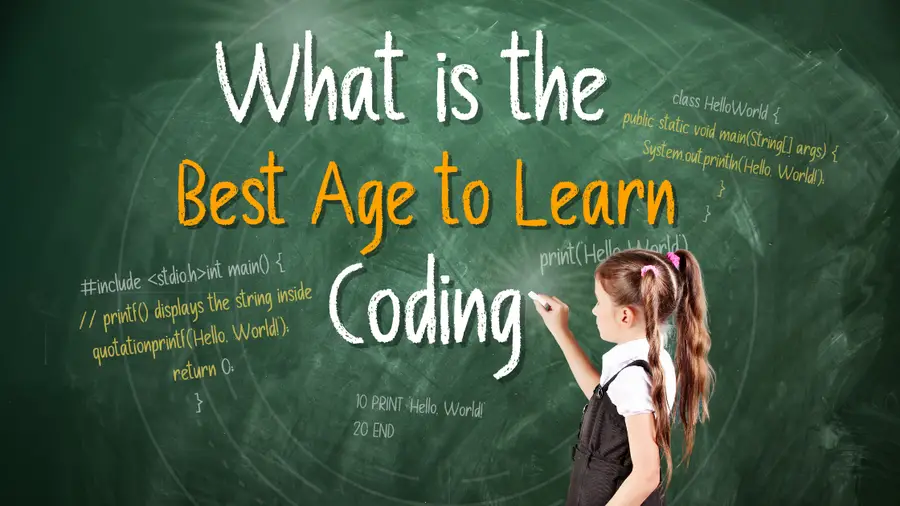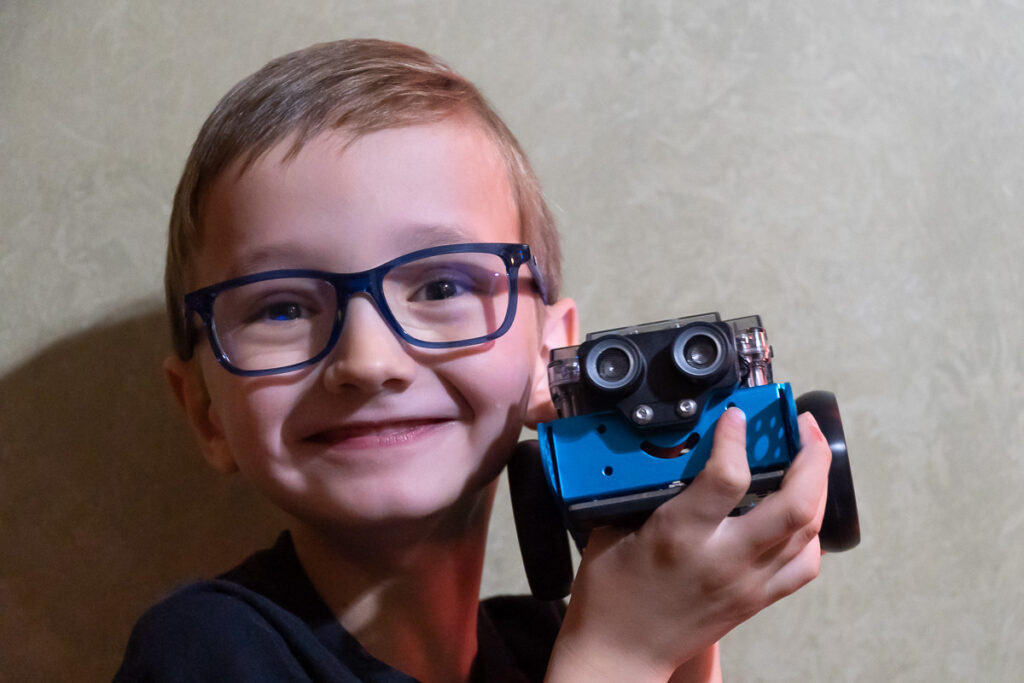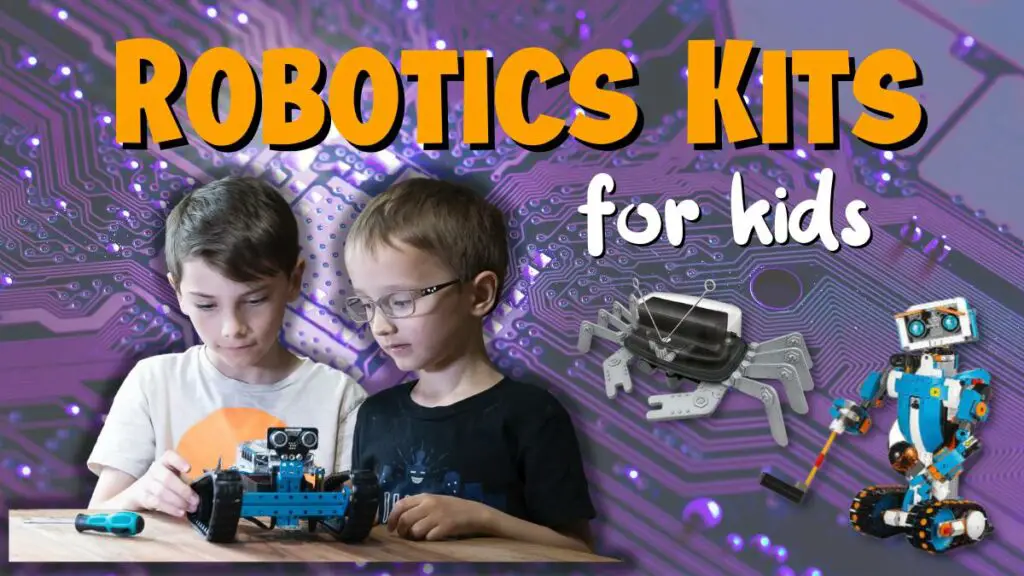In recent years, people have begun to seriously ask how important is for children to learn code. Debates sprang up if all future careers would require some level of coding knowledge. While the initial panic seems unwarranted, technology increasingly becomes embedded in our daily lives. Thus, learning some coding can be beneficial. But what is the best age to start coding?
The best age to start coding is when a child is young, as early as five. However, the exact age is debated, some saying it is better to wait until around eight. Most agree that coding should be introduced by ten, as that is the top age bracket to introduce a foreign language and still achieve fluency.

*We’re an affiliate – we may earn a commission through qualifying purchases from the links on this page. As always, thanks!*
Being a programmer is not like being a translator. There are many programming languages, and technology is changing faster than your last phone upgrade. It is great to introduce coding by 10, but while there are products for toddlers, it is probably best to focus on foundational STEM toys, including blocks. Much of coding is about how you think, and being exposed to coding concepts early is a great learning opportunity.
Why it is Suggested to Introduce Coding by Age 10
General advice is to introduce a child to coding by ten. If your five-year-old is desperate to code, great, do it. Plenty of research shows coding young, as early as five, is beneficial. But if you are reading this and your kid is ten, don’t panic. It’s not too late to start. You and their school have not failed them if they’ve yet to try coding.
Parents and educators are encouraged to introduce coding to children between 5 and 10 due to what we know about learning a second verbal language. Because of how the brain develops, introducing foreign languages by ten is best to achieve future fluency in that additional language. Some kids are even born with parents who speak two or more languages, and the child swings between both, often “mixing them” until around five or six.
(Please note that “mixing” two languages and being “confused” are separate matters. Research says that bilingual children are not confused.)
That said, coding is not the same as verbal language. Verbal languages are often not logical. English, for example, is incredibly exasperating to learn as an additional language because it breaks its own rules. This is very different from, say, mathematics, which follows its rules.
Coding requires logical thought, problem-solving, critical thinking, and creativity. Coding can help develop those skills, but so can many other types of childhood play: music, art, LEGO, chess, puzzles, marble runs, and Lincoln Logs. Thus, a logical and creative child who has only been introduced to coding at ten is going to be fine.
So no, you don’t need to rush out and buy your 36-month-old child a Code-a-pillar or mbot Neo. But you might want to buy your 36-month-old child a Code-a-pillar or mBot because it’s fun, and you, the adult, want to play with it too (of course you do.) But while a robot kit is a wonderful introduction to coding, it is also not going to guarantee your three-year-old is the next Bill Gates.
Your child might be put off by coding if you introduce it too young and are too pushy about it. Our kids are 4 and 6, and we’re dipping our toes in to coding. They’re enjoying the toys and our older son is getting into block based programming, and eyeing up some of the Lego robotics kits.
Note – I’m more of a “geek dad” who’s professional career occasionally drifts into coding than a heavy duty programmer, so this is something he’s developed an interest in himself more than trying to emulate. In other words, it’s exposure to the concepts and mild encouragement more than being heavy handed.
So far this approach is working for us (and the kids.) They may take to coding and become passionate about it, or they may go through the phase and move on to other interests. It is good to try out a variety of interests before narrowing your focus. For us it’s about creating the opportunities and options for them and not being too pushy. But every kid is different. It’s that simple and complicated.
How to Get Your Child Started in Coding?
There are many ways to introduce coding, and some are more accessible and affordable than others. There are websites, games, toys, school clubs, online clubs, and apps. It is crucial to be honest about your resources (both time and budget) and your child’s personality. But most of all, it is essential to make it fun.
When I was first exposed to coding, options were far more limited. Pick up a book on a popular programming language of choice or a niche magazine and get digging (Yes, it’s been a long time since I’d been taught BASIC; I knew there had to be better ways for our kids.)
While picking up a book and teaching yourself is certainly doable and cheap(er) than some other options, it does not necessarily spark delight. Now you can find a variety of free online coding tutorials to get started. This is a great way to determine aptitude and check out different languages with low risk.
There is a whole industry around coding toys, which is a great way to introduce some basic concepts through play. We’ll discuss some of these below.
There are other opportunities worth checking out that may be more engaging for young minds: Young Engineers or First Lego League are fun activities that encourage teamwork and competition. Some people approach such leagues with all the fervor and passion as they would a sporting event (We’ll take a look at some of these down below as well.)
Our oldest son gets inspired by playing games in the community on Scratch, and is realizing he can create his own. Discovering you can program “mods” on games such as Terraria and Minecraft can be a great motivator. Are they programming, or playing; the lines start to blur because kids get so engaged. This is when the programming bug truly bloomed: when coding became fun.
Starting Your Child with Syntax or Drag-and-Drop?
Programming languages are numerous, but they come in two forms: syntax and drag-and-drop.
Syntax languages are the coding version of “writing a story” using “sentences.” Some are easier to read and a bit more intuitive than others, though all are based on lines instructions that form a program. Popular examples of syntax languages are:
Syntax languages are generally what comes to mind when people think of programming. Most serious programmers have to know many different syntax languages. Not only is technology always changing, but some clients are “stuck” with a language due to when they first developed a product. (I still come across businesses that have COBOL lingering in their systems.)
Berkeley Extension listed eleven most in-demand languages for 2021, including C#, JavaScript, Python, and Rust. Python and JavaScript are probably the best first languages to try. Rust is not the best option to begin with of the four. It is a great language, but it assumes you’ve had some syntax experience, including with C++.
Now, a drag-and-drop language is more like being handed a fun and colorful worksheet with stickers that can be “dragged” over to the worksheet’s blank spots and “dropped” into the slot. Some drag-and-drop interfaces are:
- Beetle Blocks
- Blockly
- Code.org
- Scratch (and Scratch Jr)
Drag-and-drop is an excellent method to introduce coding to younger children. For starters, it is usually colorful, which makes it look fun. It is also easy because you don’t have to learn coding “grammar” and worry about a random “;” lurking in your syntax.
With these languages, you just grab the block you want and drop it in. Drag-and-drop is also used in the majority of coding toys. (Keep reading for some examples.)
Another advantage is that drag-and-drop makes it easy to find and fix mistakes. In syntax, it can get a bit needle-in-a-haystack. In my career as a professional consultant, I can’t tell you how many epic troubleshooting sessions I’ve been in that have ended by finding a single errant character a client had misplaced within a wall of code. This can be frustrating for anyone, but might make a small child give up.
The whole point of introducing coding is to get a kid interested, not to frustrate them. Once drag-and-drop was discovered, coding no longer resembled homework.
Older children, however, might be frustrated about the restrictiveness with drag-and-drop. Going from something like Python or kids may be exploring languages like Lua, C#, and Javascript, which are needed to make mods or games for Roblox, Terraria, and Minecraft, going to a drag-and-drop language can feel limiting.
Drag and drop would be the best place to start a young one on their coding journey. They can advance through several block based languages and get a firm foundation early on before advancing to syntax based languages.
How to Move Your Child from Drag-and-Drop to Syntax?
If you introduce coding to your child with drag-and-drops, you can eventually use a bridging system to help move over to syntax. MakeCode, for example, can start your child off on blocks and then move the young programmer on to syntax with JavaScript.
Pencil Code allows users to work in blocks or syntax. Using “dual-mode,” the child can program in, say, blocks and then see what that looks like in syntax on the other half of the screen.
Codey Rocky from Makeblock is a robot kit designed to teach coding. It has a block coding interface that can show the same commands in Python. It’s designed to allow kids to start with block based coding and progress to Python as their knowledge and skills grow. Codey Rocky is ready to go out of the box and is it’s design and expressions may appeal to younger kids.
There is also Stride, a frame-based programming language. It integrates the advantages of both blocks and syntax. The layout makes it easier to read and edit than a standard syntax language. This isn’t only a great transition language but an excellent introduction to code for a child around 7-8 who might sneer at blocks but isn’t really to jump into Python just yet.
LEGO is also starting to bridge between blocks and syntax. LEGO used to only run on drag-and-drop based on Scratch but now has options to use Python.
LEGO is the equipment used for many children’s robotic competitions, including First LEGO League. In the past, LEGO’s big product was the EV3. However, it is being phased out (or already gone, depending on where you are) for the LEGO MINDSTORMS Robot Inventor. You can even get a brick for Python called Pybricks.
8 Coding Toys, Kits, and Games
Thanks to the growing trend in STEM toys, there are more options than ever in finding toys, kits, and games to help make coding fun. Here are 7 quick overviews for you to consider and give you an idea of what is available. If you’re looking for more we have a full post dedicated to coding toys and games.
Makeblock mBot Neo

The mBot Neo is a robot and coding kit designed to make learning about technology and computer science engaging and accessible. (It’s kind of the big brother to the Codey Rocky unit mentioned above.)
Built around the versatile CyberPi mainboard, it offers precision in movement control and is equipped with advanced sensors. The mBot stands out for its ease of assembly and user-friendly learning approach, making it ideal for educational settings.
You can get going quickly remote controlling it through the app, or use the demo modes to play. It really shines when you dig into coding – it supports drag and drop block based for beginners, and Python for more advanced users.
It may be a bit pricier than some of the coding “toys,” though it has a much sturdier build quality and offers more versatility and longevity. It’s worth a bit extra for the investment. Check out our full review of the mbot Neo.
Botley 2.0
Botley the Coding Robot is an award-winning STEM toy for children between 5-9 that focuses on early programming skills. Botley can be customized through various “masks” that have nothing to do with pandemics. Botley can also be altered to be objects such as a train or a police car. The children program Botley to do various maneuvers and obstacle courses.
Coding Critters
Coding Critters is an adorable and award-winning line of STEM interactive toys aimed at kids 4 years and up. The critters are various, including Skye the Unicorn, Blazer the Dragon, and Scrambles the Fox. This is a screen-free toy that works on preschool-aged coding skills.
Kano Computer Kit
Building a computer is a good experience for any future programmer. It’s also the best way to get the most value for your money. However, some kids are intimidated by doing it from scratch, which is understandable. Thus, the award-winning Kano Computer Kit makes it easy to build your first computer.
The emphasis remains on the software side, however. So once the kit is assembled, the young programmer will have access to games and lessons to improve their coding skills while also making art and music.
Kids First Coding & Robotics
Kids First Coding & Robotics is aimed at children 4-8 years old. It doesn’t require another device, such as a tablet or laptop, to work, providing a break from screens. The cute kit uses stories and coding cards, along with a 64-page manual that is bright and colorful.
OJO STEM Board Games
OJO has a series of STEM board games for kids 4+ that include Robot Workshop to “design and build robots for space missions on an alien world.” Other board games include Space Rescuers and Atomic Force. This isn’t specifically coding, but the games promote STEM skills and give kids a break from screens.
Sphero SPRK+
Sphero SPRK+ is a robotic ball that is aimed at children between 8-14 years old. The toy runs on one lithium battery and works with IOS or Android. There is also the Sphero BOLT or Mini, which are excellent alternatives.
If using the Sphero Edu app, the SPRK+ can be programmed using JavaScript rather than just Scratch, making it a choice that can grow with young coders.
If your kids (or you) are a Star Wars fan like ours, you can also opt for the BB-8 Shpero.
OSMO Coding Starter Kit
OSMO Coding Starter Kit is designed to work with an iPad. It is aimed at children between 5-10. It’s fun, colorful, and accessible.
Check out our post on robotics kits for kids for more coding toys!
Robot Competitions and Game Jams
Giving children a goal, such as a competition, is a fun way to build enthusiasm for coding. Two ways to do this are through robotics competitions and Game Jams. The former has many drag-and-drop options, which makes it incredibly accessible to younger kids. Game Jams, however, tend to favor C++ and C#, syntax programming languages.
5 Robotic Competitions
Robotic competitions are often done in teams assembled through clubs or schools. Usually, a coach or supervisors assist the students (and takes care of the mountain of paperwork.) While there are virtual participation options, many tournaments involve competing in person. Here are five popular options to consider:
- Botball
Botball is a team robotics program for students in middle and high school. The program involves various STEM skills, including science, engineering, technology, math, and, as a bonus, writing skills. Robots are programmed using C, C++, and Java.
- First LEGO League
First LEGO League has local competitions around the globe that can eventually lead to an international event. There are three age divisions and teams, and each year has a theme. The children compete on robot design and how well it does in an obstacle course. They also present an independent theme-based project.
- MakeX
MakeX is a STEAM multidisciplinary competition that involves robotics. It is incredibly popular for children between the ages of 6 – 13. Each year is centered around a theme, and the aim is to develop kids’ problem-solving, logical thinking, creativity, and imagination.
- VEX Robotics
VEX Robotics is a highly regarded robotic program in over 50 countries. There are various types of tournaments and age groups. There are even opportunities for teams to participate virtually.
- World Robot Olympiad
World Robot Olympiad runs competitions worldwide with participants from 60 countries. The competition runs in four categories at various age groups. Their “Regular” and “Open” categories involve children as young as eight. “Football” is only for students 10 and over and will debut in 2022, and “Future Engineers” must be 14 or older.
There is also a separate fifth program called WeDo for children up to age 10 that works with the LEGO Education WeDo platform.
Depending on the category and level, the children use LEGO or equipment of their choice. The actual software, however, has no restrictions.
5 Game Jams
Game Jams are video game competitions and are virtual events without age groups. These are much more casual than robotics competitions, so teams are typically made up of friends, often comprised of a programmer, designer, and graphic artist.
A jam is usually 48 hours, meaning most teams stagger their sleep or skip it. The jam’s theme is announced at the start of the clock, and everyone scrambles to make a video game that incorporates the theme. 5 Game Jams and platforms that host them are:
Wrap Up – What’s the best age to start coding?
The best age to coding may be subjective depending on the individual, though most experts agree on an age range between 5 and 10 years. Our oldest son showed an interest in coding toys as early as 4 years old and was playing with Scratch Jr and Code.org around age 5. We’re waiting to see where he goes with it next, and will provide the resources and opportunities as he advances. (and I’m thinking it would be a great time to get some of the new Lego kits – you know, for the kids!)
Learning to code is a valuable skill to develop, even if you’re not planning a career in programming. Everybody doesn’t need to become a software engineer or developer, though being able to look at a few lines of code and understand the basic purpose of the program is helpful. The basic concepts, logic, and problem solving skills used in coding translate to any career (and are just solid life skills.)
Coding can be an art form and some developers strive to create beautiful code or clean code. For some, creating a piece of code can provide a creative outlet much like art activities.
The trick for introducing it to children is to make it fun and accessible. Thankfully, there is a range of products, platforms, and opportunities out there to appeal to various ages, personalities, and budgets.
If you want to look ahead and get a sense of job opportunities for coders, check the listings at FindSoftwardDeveloperJobs.com. This should provide a sense of what is available.


